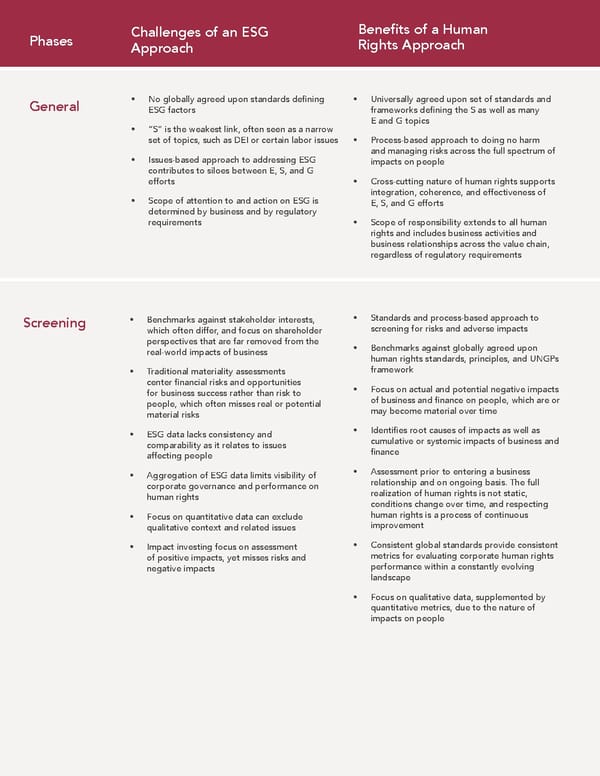Phases Challenges of an ESG Benefits of a Human Approach Rights Approach General • No globally agreed upon standards defining • Universally agreed upon set of standards and ESG factors frameworks defining the S as well as many • “S” is the weakest link, often seen as a narrow E and G topics set of topics, such as DEI or certain labor issues • Process-based approach to doing no harm • Issues-based approach to addressing ESG and managing risks across the full spectrum of contributes to siloes between E, S, and G impacts on people efforts • Cross-cutting nature of human rights supports • Scope of attention to and action on ESG is integration, coherence, and effectiveness of determined by business and by regulatory E, S, and G efforts requirements • Scope of responsibility extends to all human rights and includes business activities and business relationships across the value chain, regardless of regulatory requirements Screening • Benchmarks against stakeholder interests, • Standards and process-based approach to which often differ, and focus on shareholder screening for risks and adverse impacts perspectives that are far removed from the • Benchmarks against globally agreed upon real-world impacts of business human rights standards, principles, and UNGPs • Traditional materiality assessments framework center financial risks and opportunities • Focus on actual and potential negative impacts for business success rather than risk to of business and finance on people, which are or people, which often misses real or potential may become material over time material risks • ESG data lacks consistency and • Identifies root causes of impacts as well as comparability as it relates to issues cumulative or systemic impacts of business and affecting people finance • Aggregation of ESG data limits visibility of • Assessment prior to entering a business corporate governance and performance on relationship and on ongoing basis. The full human rights realization of human rights is not static, conditions change over time, and respecting • Focus on quantitative data can exclude human rights is a process of continuous qualitative context and related issues improvement • Impact investing focus on assessment • Consistent global standards provide consistent of positive impacts, yet misses risks and metrics for evaluating corporate human rights negative impacts performance within a constantly evolving landscape • Focus on qualitative data, supplemented by quantitative metrics, due to the nature of impacts on people 15 HOW BUSINESS CAN BUILD A ‘FUTURE OF WORK’ THAT WORKS FOR WOMEN
 Human Rights Roadmap for Transforming Finance Page 14 Page 16
Human Rights Roadmap for Transforming Finance Page 14 Page 16